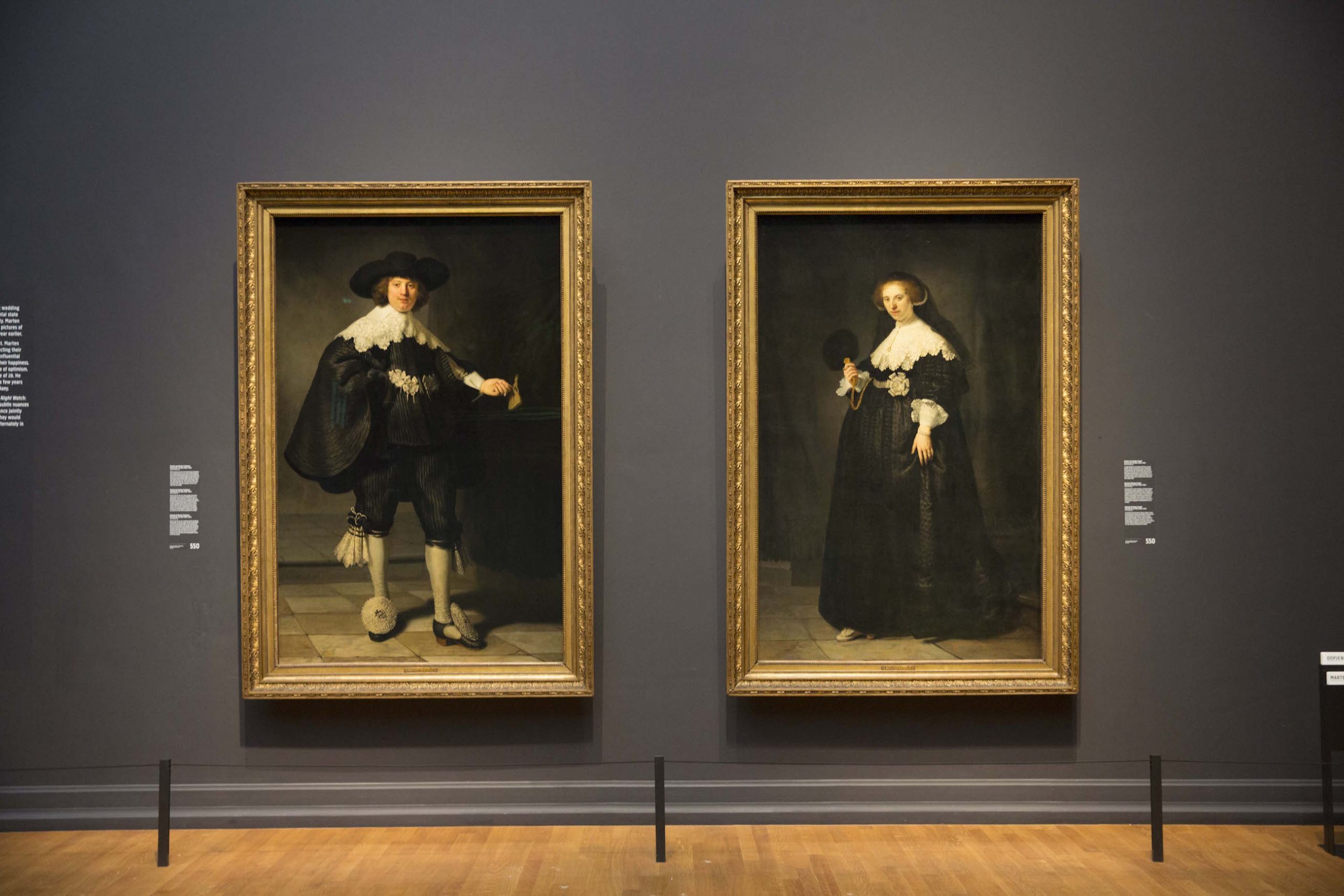 We are delighted to welcome Danielle Carter, owner of Tangible Education and museum educator for Thinking Museum, to write for us. You can learn more about Danielle’s research, educational and practical experience here.
We are delighted to welcome Danielle Carter, owner of Tangible Education and museum educator for Thinking Museum, to write for us. You can learn more about Danielle’s research, educational and practical experience here.
There have been numerous images of Rembrandt’s Marten and Oopjen (1634) splashed across billboards and walls throughout Amsterdam for the past few months. Some solely featured Marten’s extravagant shoe. Some featured Oopjen’s coy half-smile and smouldering eyes. However, it’s hard to really understand the significance of these portraits without more context. This is where we, at Thinking Museum, can assist: the importance of Marten and Oopjen from the museological, historical, and art historical perspective.
From a museological standpoint, the display and acquisition of these paintings is what counts. These paintings have only been shown once in public—in 1956 in the Rijksmuseum for Rembrandt’s 350th birthday. Other than that, they have remained in private hands over the past three and a half centuries—unseen by the public eye. Thus the fact that we have the special opportunity to see these paintings is quite amazing in itself. Furthermore, these paintings were revealed in the Rijksmuseum shortly before Rembrandt’s 410th birthday (on July 14th of this year), a serendipitous arrangement that has given me goosebumps several times. The paintings will go into restoration for a year starting in October, so they will soon be out of the public eye once more.
Additionally, these paintings were—to say the least—pricey. Paintings by Rembrandt are hard to come by and a situation in which one (or two!) comes onto the market is very rare. Even more importantly, however, is that the Rijksmuseum and the Louvre partnered to purchase these paintings. This is unheard of in the museum world thus far, but seems to be a solution to a prevalent issue in the contemporary art world; the fact that private collectors are able to outbid public museums and artworks are thus swept into private collections rather than preserved for the public eye. Technically speaking, the Louvre purchased Oopjen and the Rijksmuseum purchased Marten, but the two museums have agreed that the two paintings will remain together forever. The two paintings are married just as the couple once was.
Historically speaking, these paintings indicate a large amount about the Dutch Golden Ages. During this time, the Netherlands was waging war with the Spanish crown to gain its independence, after which it would establish a republic (rather than a monarchy). During the Dutch Golden Ages, royalty are typically the only ones who have full-length portraits painted; Rembrandt has painted these two “civilians” in this manner, symbolising the status of the wealthy in the Netherlands as well as the (lack of) status of the aristocracy. Oopjen herself was the heir of her long-established Amsterdam merchant family’s fortune in trading gunpowder and grain, whereas Marten was the son of an Antwerp merchant who fled from the cruel Spanish regime enforcing the Inquisition at that time. Again, societal structure was much more based on affluence rather than aristocratic title, lending Rembrandt the authority to paint Marten and Oopjen in this manner that would typically be preserved for royalty.
Finally, for the art history lovers out there, there are many reasons to gawk at these portraits. Rembrandt was relatively new on the scene in Amsterdam at the time that he painted these portraits. They were painted during the same period that he painted The Anatomy Lesson, which is often regarded as the painting that initiated his fame as well as his status as the most prominent portrait painter in Amsterdam. However, because Marten and Oopjen were truly part of the elite, it is very plausible that these wedding portraits launched Rembrandt’s notoriety among the highest and wealthiest of circles in the Netherlands, skyrocketing his reputation—when he was just 28 years old.
Furthermore, these portraits are the first—and only—full-length, life-sized pendant portraits that Rembrandt ever painted. And he painted every single detail of them, rather than having one of his apprentices help with the fabric or background (as he often did with other paintings). These paintings are also relatively typical of Rembrandt’s style early on in his career in Amsterdam. Although the Night Watch (1642) is definitely his most famous painting, his technique and style becomes much more loose by that time, making the juxtaposition of these masterpieces in the Gallery of Honour that much more remarkable.
Make sure you get a chance to marvel at these two portraits at the Rijksmuseum before 02 October!
